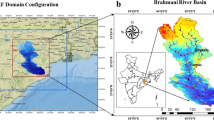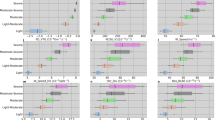Abstract
This study investigated the effects of upper-level descending inflow (ULDI) associated with inner-eyewall convection on the formation of the moat in tropical cyclones (TCs) with secondary eyewall formation (SEF). In our numerical experiments, a clear moat with SEF occurred in TCs with a significant ULDI, while no SEF occurred in TCs without a significant ULDI. The eyewall convection developed more vigorously in the control run. A ULDI occurred outside the inner-eyewall convection, where it was symmetrically unstable. The ULDI was initially triggered by the diabatic warming released by the inner eyewall and later enhanced by the cooling below the anvil cloud. The ULDI penetrated the outer edge of the inner eyewall with relatively dry air and prevented excessive solid-phase hydrometeors from being advected further outward. It produced extensive sublimation cooling of falling hydrometeors between the eyewall and the outer convection. The sublimation cooling resulted in negative buoyancy and further induced strong subsidence between the eyewall and the outer convection. As a result, a clear moat was generated. Development of the moat in the ongoing SEF prevented the outer rainband from moving farther inward, helping the outer rainband to symmetrize into an outer eyewall. In the sensitivity experiment, no significant ULDI formed since the eyewall convection was weaker, and the eyewall anvil developed relatively lower, meaning the formation of a moat and thus an outer eyewall was less likely. This study suggests that a better-represented simulation of inner-eyewall convective structures and distribution of the solid-phase hydrometeors is important to the prediction of SEF.
摘要
本文研究了与内眼墙对流相联系的高层下沉入流(ULDI)对热带气旋(TC)外眼墙生成过程中弱回波区(Moat)形成的影响机理. 数值试验结果指出, 双眼墙和Moat通常出现在有显著ULDI的TC中, 而在没有显著ULDI的TC中没有出现双眼墙结构. 在控制试验中, 内眼墙对流发展更加旺盛, 内眼墙非绝热加热会在内眼墙高层云毡下方的对称不稳定区域激发出一支ULDI, ULDI生成后由于受到云毡下方水凝物相变过程中冷却作用的影响而增强. ULDI对Moat区形成的重要作用具体表现在: ULDI一方面使干空气入侵到内外眼墙之间的区域; 另一方面在一定程度上阻止了高层出流对水凝物的径向向外平流. 这使得更多的水凝物下落到内外眼墙之间的区域, 由于受到水凝物升华、 融化和蒸发冷却造成的负浮力的影响, 该区域的空气粒子下沉运动增强, 导致Moat区形成. Moat区的发展通过阻止外围雨带向内眼墙的收缩和合并过程, 有助于外围雨带在Moat区外侧发展成为对称的外眼墙. 在敏感性试验中, 由于TC眼墙对流较弱, 云毡发展相对较低, 没有出现明显的ULDI, 因此不太可能形成Moat区和外眼墙结构. 研究表明, 更好地再现眼墙对流结构和水凝物分布对双眼墙预报具有重要意义.
Similar content being viewed by others
References
Abarca, S. F., and M. T. Montgomery, 2013: Essential dynamics of secondary eyewall formation. J. Atmos. Sci., 70, 3216–3230, https://doi.org/10.1175/JAS-D-12-0318.1.
Adams, J. C., 1989: MUDPACK: Multigrid portable fortran software for the efficient solution of linear elliptic partial differential equations. Applied Mathematics and Computation, 34, 113–146, https://doi.org/10.1016/0096-3003(89)90010-6.
Bell, M. M., M. T. Montgomery, and W. C. Lee, 2012: An axisymmetric view of concentric eyewall evolution in Hurricane Rita (2005). J. Atmos. Sci., 69, 2414–2432, https://doi.org/10.1175/JAS-D-11-0167.1.
Braun, S. A., 2002: A cloud-resolving simulation of Hurricane Bob (1991): Storm structure and eyewall buoyancy. Mon. Wea. Rev., 130, 1573–1592, https://doi.org/10.1175/1520-0493(2002)130<1573:ACRSOH>2.0.CO;2.
Bui, H. H., R. K. Smith, M. T. Montgomery, and J. Y. Peng, 2009: Balanced and unbalanced aspects of tropical cyclone intensification. Quart. J. R. Meteor. Soc., 135, 1715–1731, https://doi.org/10.1002/qj.502.
Chen, X. Y., and L. G. Wu, 2016: Topographic influence on the motion of tropical cyclones landfalling on the coast of China. Wea. Forecasting, 31, 1615–1623, https://doi.org/10.1175/WAF-D-16-0053.1.
Didlake, A. C. Jr., and R. A. Houze Jr., 2013: Convective-scale variations in the inner-core rainbands of a tropical cyclone. J. Atmos. Sci., 70, 504–523, https://doi.org/10.1175/JAS-D-12-0134.1.
Didlake, A. C. Jr., P. D. Reasor, R. F. Rogers, and W. C. Lee, 2018: Dynamics of the transition from Spiral Rainbands to a secondary eyewall in Hurricane Earl (2010). J. Atmos. Sci., 75, 2909–2929, https://doi.org/10.1175/JAS-D-17-0348.1.
Dudhia, J., 1989: Numerical study of convection observed during the Winter Monsoon Experiment using a mesoscale two dimensional model. J. Atmos. Sci., 46, 3077–3107, https://doi.org/10.1175/1520-0469(1989)046<3077:NSOCOD>2.0.CO;2.
Fortner, C. L. E. Jr., 1958: Typhoon Sarah, 1956. Bull. Amer. Meteor. Soc., 39, 633–639, https://doi.org/10.1175/1520-0477-39.12.633.
Hawkins, J. D., and M. Helveston, 2008: Tropical cyclone multiple eyewall characteristics. Preprints, 28th Conference on Hurricanes and Tropical Meteorology, Orlando, FL, Amer. Meteor. Soc.
Houze, R. A. Jr., S. S. Chen, B. F. Smull, W. C. Lee, and M. M. Bell, 2007: Hurricane intensity and eyewall replacement. Science, 315, 1235–1239, https://doi.org/10.1126/science.1135650.
Huang, Y. H., M. T. Montgomery, and C. C. Wu, 2012: Concentric eyewall formation in typhoon Sinlaku (2008). Part II: Axisymmetric dynamical processes. J. Atmos. Sci., 69, 662–674, https://doi.org/10.1175/JAS-D-11-0114.1.
Kain, J. S., and J. M. Fritsch, 1993: Convective parameterization for mesoscale models: The Kain–Fritch scheme. The Representation of Cumulus Convection in Numerical Models, K. A. Emanuel and D. J. Raymond, Eds., Amer. Meteor. Soc., 165–170, https://doi.org/10.1007/978-1-935704-13-3_16.
Kepert, J. D., 2013: How does the boundary layer contribute to eyewall replacement cycles in axisymmetric tropical cyclones? J. Atmos. Sci., 70, 2808–2830, https://doi.org/10.1175/JAS-D-13-046.1.
Kossin, J. P., and M. Sitkowski, 2009: An objective model for identifying secondary eyewall formation in hurricanes. Mon. Wea. Rev., 137, 876–892, https://doi.org/10.1175/2008MWR2701.1.
Leighton, H., S. Gopalakrishnan, J. A. Zhang, R. F. Rogers, Z. Zhang, and V. Tallapragada, 2018: Azimuthal distribution of deep convection, environmental factors, and tropical cyclone rapid intensification: A perspective from HWRF ensemble forecasts of Hurricane Edouard (2014). J. Atmos. Sci., 75, 275–295, https://doi.org/10.1175/JAS-D-17-0171.1.
Liu, Q. Y., L. G. Wu, N. N. Qin, and Y. B. Li, 2021: Storm-scale and fine-scale boundary layer structures of tropical cyclones simulated with the WRF-LES framework. J. Geophys. Res.: Atmos., 126, e2021JD035511, https://doi.org/10.1029/2021JD035511.
Mlawer, E. J., S. J. Taubman, P. D. Brown, M. J. Iacono, and S. A. Clough, 1997: Radiative transfer for inhomogeneous atmospheres: RRTM, a validated correlated-k model for the longwave. J. Geophys. Res.: Atmos., 102, 16663–16682, https://doi.org/10.1029/97JD00237.
Montgomery, M. T., G. Kilroy, R. K. Smith, and N. Črnivec, 2020: Contribution of mean and eddy momentum processes to tropical cyclone intensification. Quart. J. Roy. Meteor. Soc., 146, 3101–3117, https://doi.org/10.1002/qj.3837.
Noh, Y., W. G. Cheon, S.-Y. Hong, and S. Raasch, 2003: Improvement of the K-profile model for the planetary boundary layer based on large-eddy simulation data. Bound.-Layer Meteor., 107, 401–427, https://doi.org/10.1023/A:1022146015946.
Qin, N. N., and D.-L. Zhang, 2018: On the extraordinary intensification of Hurricane Patricia (2015). Part I: Numerical experiments. Wea. Forecasting, 33, 1205–1224, https://doi.org/10.1175/WAF-D-18-0045.1.
Qin, N. N., L. G. Wu, and Q. Y. Liu, 2021: Evolution of the moat associated with the secondary eyewall formation in a simulated tropical cyclone. J. Atmos. Sci., 78, 4021–4035, https://doi.org/10.1175/JAS-D-20-0375.1.
Qin, N. N., L. G. Wu, Q. Y. Liu, and X. Y. Zhou, 2023: Driving forces of extreme updrafts associated with convective bursts in the eyewall of a simulated tropical cyclone. J. Geophys. Res.: Atmos., 128, e2022JD037061, https://doi.org/10.1029/2022JD037061.
Qiu, X., and Z. M. Tan, 2013: The roles of asymmetric inflow forcing induced by outer rainbands in tropical cyclone secondary eyewall formation. J. Atmos. Sci., 70, 953–974, https://doi.org/10.1175/JAS-D-12-084.1.
Rogers, R. F., P. D. Reasor, J. A. Zawislak, and L. T. Nguyen, 2020: Precipitation processes and vortex alignment during the intensification of a weak tropical cyclone in moderate vertical shear. Mon. Wea. Rev., 148, 1899–1929, https://doi.org/10.1175/MWR-D-19-0315.1.
Rozoff, C. M., D. S. Nolan, J. P. Kossin, F. Q. Zhang, and J. Fang, 2012: The roles of an expanding wind field and inertial stability in tropical cyclone secondary eyewall formation. J. Atmos. Sci., 69, 2621–2643, https://doi.org/10.1175/JAS-D-11-0326.1.
Smith, R. K., M. T. Montgomery, and H. Y. Zhu, 2005: Buoyancy in tropical cyclones and other rapidly rotating atmospheric vortices. Dyn. Atmos. Oceans, 40, 189–208, https://doi.org/10.1016/j.dynatmoce.2005.03.003.
Sun, Y. Q., Y. X. Jiang, B. K. Tan, and F. Q. Zhang, 2013: The governing dynamics of the secondary eyewall formation of typhoon Sinlaku (2008). J. Atmos. Sci., 70, 3818–3837, https://doi.org/10.1175/JAS-D-13-044.1.
Tyner, B., P. Zhu, J. A. Zhang, S. Gopalakrishnan, F. Marks, and V. Tallapragada, 2018: A top-down pathway to secondary eyewall formation in simulated tropical cyclones. J. Geophys. Res.: Atmos., 123, 174–197, https://doi.org/10.1002/2017JD027410.
Wang, S. H., R. K. Smith, and M. T. Montgomery, 2020: Upper-tropospheric inflow layers in tropical cyclones. Quart. J. Roy. Meteor. Soc., 146, 3466–3487, https://doi.org/10.1002/qj.3856.
Wang, S. H., M. T. Montgomery, and R. K. Smith, 2021: Solutions of the Eliassen balance equation for inertially and/or symmetrically stable and unstable vortices. Quart. J. Roy. Meteor. Soc., 147, 2760–2771, https://doi.org/10.1002/qj.4098.
Wang, H., Y. Wang, and H.-M. Xu, 2013: Improving simulation of a tropical cyclone using dynamical initialization and largescale spectral nudging: A case study of Typhoon Megi (2010). Acta Meteor. Sin., 27, 455–475, https://doi.org/10.1007/s13351-013-0418-y.
Wang, Y.-F., and Z.-M. Tan, 2020: Outer rainbands–driven secondary eyewall formation of tropical cyclones. J. Atmos. Sci., 77, 2217–2236, https://doi.org/10.1175/JAS-D-19-0304.1.
Willoughby, H. E., J. A. Clos, and M. G. Shoreibah, 1982: Concentric eye walls, secondary wind maxima, and the evolution of the hurricane vortex. J. Atmos. Sci., 39, 395–411, https://doi.org/10.1175/1520-0469(1982)039<0395:CEWSWM>2.0.CO;2.
Wu, L. G., Q. Y. Liu, and Y. B. Li, 2018: Prevalence of tornado-scale vortices in the tropical cyclone eyewall. Proceedings of the National Academy of Sciences of the United States of America, 115, 8307–8310, https://doi.org/10.1073/pnas.1807217115.
Wu, L. G., Q. Y. Liu, and Y. B. Li, 2019: Tornado-scale vortices in the tropical cyclone boundary layer: Numerical simulation with the WRF–LES framework. Atmospheric Chemistry and Physics, 19, 2477–2487, https://doi.org/10.5194/acp-19-2477-2019.
Wunsch, K. E. D., and A. C. Didlake, 2018: Analyzing tropical cyclone structures during secondary eyewall formation using aircraft in situ observations. Mon. Wea. Rev., 146, 3977–3993, https://doi.org/10.1175/MWR-D-18-0197.1.
Yu, C.-L., and A. C. Didlake Jr., 2019: Impact of stratiform rainband heating on the tropical cyclone wind field in idealized simulations. J. Atmos. Sci., 76, 2443–2462, https://doi.org/10.1175/JAS-D-18-0335.1.
Yu, C.-L., A. C. Didlake Jr., and F. Q. Zhang, 2022: Updraft maintenance and axisymmetrization during secondary eyewall formation in a model simulation of Hurricane Matthew (2016). J. Atmos. Sci., 79, 1105–1125, https://doi.org/10.1175/JAS-D-21-0103.1.
Yu, C.-L., A. C. Didlake Jr., F. Q. Zhang, and R. G. Nystrom, 2021: Asymmetric rainband processes leading to secondary eyewall formation in a model simulation of Hurricane Matthew (2016). J. Atmos. Sci., 78, 29–49, https://doi.org/10.1175/JAS-D-20-0061.1.
Zhang, D.-L., L. Zhu, X. J. Zhang, and V. Tallapragada, 2015: Sensitivity of idealized hurricane intensity and structures under varying background flows and initial vortex intensities to different vertical resolutions in HWRF. Mon. Wea. Rev., 143, 914–932, https://doi.org/10.1175/MWR-D-14-00102.1.
Zhao, K., Q. Lin, W.-C. Lee, Y. Q. Sun, and F. Q. Zhang, 2016: Doppler radar analysis of triple eyewalls in Typhoon Usagi (2013). Bull. Amer. Meteor. Soc., 97, 25–30, https://doi.org/10.1175/BAMS-D-15-00029.1.
Zhu, T., and D.-L. Zhang, 2006: Numerical simulation of Hurricane Bonnie (1998). Part II: Sensitivity to varying cloud microphysical processes. J. Atmos. Sci., 63, 109–126, https://doi.org/10.1175/JAS3599.1.
Zhu, Z. D., and P. Zhu, 2014: The role of outer rainband convection in governing the eyewall replacement cycle in numerical simulations of tropical cyclones. J. Geophys. Res.: Atmos., 119, 8049–8072, https://doi.org/10.1002/2014JD021899.
Zhu, Z. D., and P. Zhu, 2015: Sensitivities of eyewall replacement cycle to model physics, vortex structure, and background winds in numerical simulations of tropical cyclones. J. Geophys. Res.: Atmos., 120, 590–622, https://doi.org/10.1002/2014JD022056.
Acknowledgements
This study was jointly supported by the National Natural Science Foundation of China (Grant Nos. 42192552, 42192551, 42150710531, 42175016, and 42075072), the Shanghai Typhoon Research Fund (Grant No. TFJJ202207), and the Basic Research Fund of CAMS (Grant No. 2023Y010) We thank Dr. Qingyuan LIU from the Nanjing Joint Institute for Atmospheric Sciences for his help in conducting the simulations.
Author information
Authors and Affiliations
Corresponding author
Additional information
Article Highlights
• Strong inner-eyewall convection with considerable diabatic heating promoted the formation of upper-level descending inflow.
• The cooling process of solid hydrometeors enhanced the subsidence in the persistent moat.
• Moat development in ongoing SEF prevented the outer rainband from moving farther inward, helping it to symmetrize into an outer eyewall.
• Better-simulated inner-eyewall convective structures with a reasonable description of the microphysical processes is crucial for predicting SEF.
Rights and permissions
About this article
Cite this article
Qin, N., Wu, L. Roles of Upper-Level Descending Inflow in Moat Development in Simulated Tropical Cyclones with Secondary Eyewall Formation. Adv. Atmos. Sci. 41, 1100–1114 (2024). https://doi.org/10.1007/s00376-023-3075-9
Received:
Revised:
Accepted:
Published:
Issue Date:
DOI: https://doi.org/10.1007/s00376-023-3075-9




